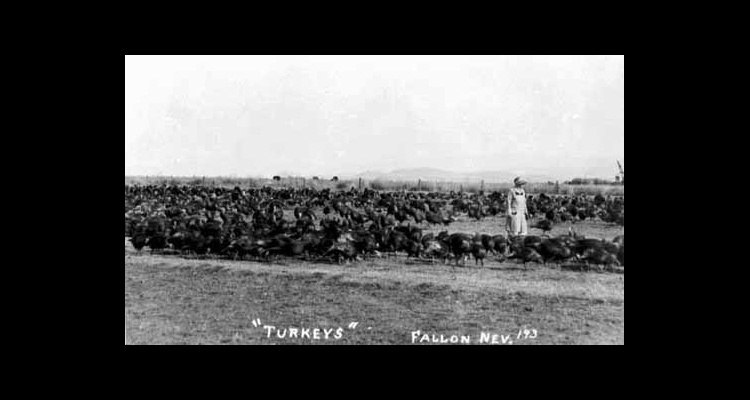Fallon Tom Turkey
Generations after the once profitable turkey-growing industry in Churchill County had ceased to exist, menus and newspaper advertisements for popular Reno casinos and restaurants still promoted "Roasted Fallon Tom Turkey."
Turkeys had been grown in Lahontan Valley since the 1860s, but it was in about 1914— during the establishment of the Newlands Reclamation Project—that residents realized the local climate was ideal for poultry breeding. Eventually, eighty farms were involved in the business, which reached its apex in 1928 when it was reported that there were approximately 67,000 birds in the county. Growers formed the Churchill County Poultrymen, Incorporated, to provide marketing support through the Diamond N and Norbest labels.
In the early days of the industry, poults (young turkeys) were shipped by “overnight train” into the valley from California in boxes, each containing 100 baby birds. Each poult had to be given a little bit of food and have its beak dipped into water, so it could learn how to eat and drink. In the fall, the dressed birds were once again delivered to cool packing sheds near the railroad depot, awaiting their final train trip to dining room tables across America. After growers experimented with different varieties of turkeys, the larger Bronze bloodline became popular. Local farmer L. E. Gow developed a variety known as “Sagebrush Giant.” As the years went by, local superior breeding stock was saved and most poults were hatched in the county.
Some growers allowed their birds to roam free, grazing in alfalfa fields on insects and plants, in addition to being fed a grain supplement. One drawback to this practice was that weasels, coyotes, badgers, skunks, and bobcats loved adding protein to their diets also. In addition, growers had to contend with diseases, insects such as red mites, and natural disasters including heat, wind, rain, and hail storms. Despite these challenges, raising poultry proved to be a good cash crop for the homesteader who was still developing his land.
One prominent grower who earned the title of “Turkey Queen” was Anna Johnson. In 1910, Johnson was a forty-one-year-old church deaconess and teacher, broken in health and finances when she came to Fallon and claimed acreage under the federal Homestead Act of 1862. Raising as many as 600 birds a year, she was soon able to purchase an automobile and construct a new home.
Minnie Pauline Blair arrived in Fallon on a cold and windy April day in 1924 with her husband and family. She soon began raising turkeys, in a very confined area, where sanitation practices were of the utmost importance. By 1930, Blair was in the turkey business on a commercial scale, shipping her prime turkeys—under the “Atlasta Turkey” brand—to thirty-eight states and Washington, D.C., where she provided Thanksgiving dinner for President Franklin D. Roosevelt's White House gathering.
After World War II began, Blair found it impossible to hire the necessary help to harvest the turkey crop. By 1947, her poultry business was phased out, but Blair's joy of cooking prompted her to open a Spudnut donut shop and restaurant.
Bodie Graham, an industrious Native American who lived on the Fallon Paiute-Shoshone Indian Reservation, raised thousands of turkeys on his small farm. Each fall he bartered with a local merchant, the I. H. Kent Company, trading turkeys for the supplies his family used throughout the year.
The turkey industry fell upon hard times after World War II. Today, only memories of Fallon Tom Turkey remain.
Article Locations
Related Articles
None at this time.
